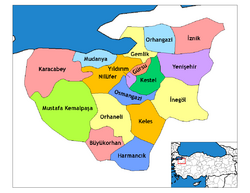Bursa
| Bursa | |||
|---|---|---|---|
 |
|||
|
|||
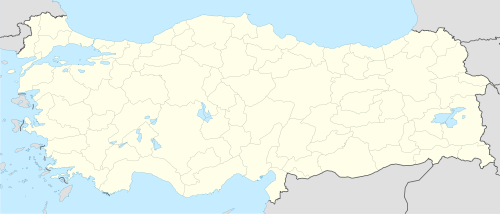 Bursa
|
|||
| Coordinates: | |||
| Country | |||
| Region | Marmara | ||
| Province | Bursa | ||
| Settled | 202 BC | ||
| Government | |||
| - Mayor | Recep Altepe (AKP) | ||
| Area | |||
| - Three districts | 1,036 km2 (400 sq mi) | ||
| Elevation | 100 m (328 ft) | ||
| Population (2009)[1] | |||
| - City | 2,550,645 | ||
| - Density | 1,508.52/km2 (3,907/sq mi) | ||
| - Urban | 1,854,634 | ||
| Time zone | EET (UTC+2) | ||
| - Summer (DST) | EEST (UTC+3) | ||
| Postal code | 1600 | ||
| Area code(s) | (+90) 224 | ||
| Licence plate | 16 | ||
| Website | www.bursa.bel.tr | ||
Bursa (Greek: Προύσα, Prousa) is a city in northwestern Turkey and the seat of Bursa Province. With a population of 2,550,645 (2009),[2] it is Turkey's fourth largest city, as well as one of the most industrialized and culturally charged metropolitan centers in the country.
Bursa is settled on the northwestern slopes of Mount Uludağ in the southern Marmara Region. It is bordered by the Sea of Marmara and Yalova to the north; Kocaeli and Sakarya to the northeast; Bilecik to the east; and Kütahya and Balıkesir to the south.
The city is frequently cited as "Yeşil Bursa" (meaning "Green Bursa") in a reference to the parks and gardens located across its urban tissue, as well as to the vast forests in rich variety that extend in its surrounding region. The city is synonymous with Mount Uludağ which towers behind its core and which is also a famous ski resort. The mausoleums of early Ottoman sultans are located in Bursa and the numerous edifices built throughout the Ottoman period constitute the city's main landmarks. The surrounding fertile plain, its thermal baths, several interesting museums, notably a rich museum of archaeology, and a rather orderly urban growth are further principal elements that complete Bursa's overall picture.
Karagöz and Hacivat shadow play characters were historic personalities who lived and are buried in Bursa. Bursa is also home to some of the most famous Turkish dishes, especially candied chestnuts and İskender kebap. Its peaches are also well-renowned. Among its depending district centers, İznik, historic Nicaea, is especially notable for its long history and important edifices. Bursa is home to the Uludağ University, and its population attains one of the highest overall levels of education in Turkey. The city has traditionally been a pole of attraction, and was a major center for refugees from various ethnic backgrounds who immigrated to Anatolia from the Balkans during the loss of the Ottoman territories in Europe between the late 19th and early 20th centuries.
Contents |
History

The earliest known site at this location was Cius, which Philip V of Macedonia granted to the Bithynian king Prusias I in 202 BC, for his help against Pergamum and Heraclea Pontica (modern Karadeniz Ereğli). Prusias renamed the city after himself, as Prusa.
Prusa evolved into one of the largest cities of Mysia and retained its importance for the region throughout the Hellenistic, Roman and Byzantine periods. Its strategic location on the westernmost end of the famous Silk Road ensured Prusa to remain as one of the largest centers of silk trade throughout the Medieval period.
Bursa became the first major capital city of the early Ottoman Empire following its capture from the Byzantines in 1326. As a result, the city witnessed a considerable amount of urban growth throughout the 14th century. After conquering Edirne (Adrianople) in 1365 the Ottomans turned it into a joint capital city for governing their European realms, but Bursa remained the most important Anatolian administrative and commercial center even after it lost its status as the sole Ottoman capital. The Ottoman sultan Bayezid I built the Bayezid Külliyesi (Bayezid I theological complex) in Bursa between 1390 and 1395[3] and the Ulu Cami (Great Mosque) between 1396 and 1400.[4]
During the Ottoman period, Bursa continued to be the source of most royal silk products. Aside from the local silk production, the city imported raw silk from Iran, and occasionally from China, and was the main production center for the kaftans, pillows, embroidery and other silk products for the Ottoman palaces until the 17th century.
Another traditional artisanship in the city, among many others, is knife production, which still continues today. Historically, the city was a center for the production of horse carriages during the Ottoman period. In the latter half of the 20th century, Bursa became the largest center of motor vehicle production in Turkey.
Economy
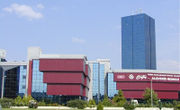
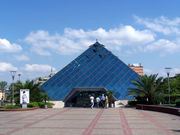
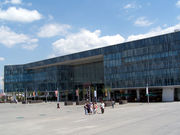

Bursa is the center of the Turkish automotive industry.[5][6] Factories of motor vehicle producers like FIAT and Renault, as well as automotive parts producers like Bosch and Mako have been active in the city for decades. The textile and food industries are equally strong, with Coca Cola, Pepsi Cola and other beverage brands, as well as fresh and canned food industries being present in the city's organized industrial zones. The top 10 industry corporations in the Bursa province are as follows.[7]
- Oyak Renault
- Tofaş
- Bosch
- Borçelik
- Türk Prysmian Kablo
- Sütaş
- Bis Enerji
- Zorlu Enerji
- Borusan Mannesmann Boru
- Componenta Döktaş
Traditionally, Bursa was famous for being the largest center of silk trade in the Byzantine and later the Ottoman empires, during the period of the lucrative Silk Road. The city is still a major center for textiles in Turkey and is home to the Bursa International Textiles and Trade Center (Bursa Uluslararası Tekstil ve Ticaret Merkezi, or BUTTIM.) Bursa was also known for its fertile soil and agricultural activities, which have decreased in the recent decades due to the heavy industrialization of the city.
Bursa is a major center for tourism. One of the most popular skiing resorts of Turkey is located at Uludağ just next to the city proper. Bursa's thermal baths have been used for therapeutical purposes since Roman times. Apart from the baths that are operated by hotels, Uludağ University has a physical therapy center which also makes use of thermal water.
Education
Uludağ University is located in Bursa and is a prominent university in Turkey's Marmara Region. It was founded in 1975, first as the Bursa University, then re-named as the Uludağ University in 1982. In the 2005–06 academic year, the university had a student body of 47,000. Private Bilgi University has announced plans to open first a two-year and later a four-year university in Bursa within next four years.
Places of interest
A brief list of places of interest in and around Bursa is presented below. For a longer list, see places of interest in Bursa.
- Irgandi Covered Bridge
- Yeşil Cami or the Green Mosque
- Uludağ National Park
- Bursa city walls
- Hot springs;
- Çekirge
- Armutlu
- Oylat
- Gemlik
- Beaches;
- Armutlu
- Kumla
- Kurşunlu
- Mudanya
- Palace and Hipogeum
- Orhan Mosque and complex
- Muradiye complex
- Yeşil complex
- Bayezid I Mosque and complex (külliye)
- Emir Sultan Mosque and complex (külliye)
- Hüdavendigar complex
- Koza Han
- Pirinç Han
- Koca Sinan Paşa complex
- İshak Paşa complex
- Çelik Palas, thermal bath
- Bursa Grand Mosque
- Karacabey Grand Mosque
- Yıldırım Bazaar
- Museums;
- Bursa Archeology Museum
- Bursa City Museum [2]
- Bursa Atatürk Museum
- Bursa Turkish Architecture Museum
- Islamic Works Museum
- Mudanya Armistice
- İznik Museum
- Cumalıkızık village
- Bursa Zoo and Botanical Garden (Bursa Hayvanat Bahçesi ve Botanik Parkı)
Ulu Cami (The Great Mosque)
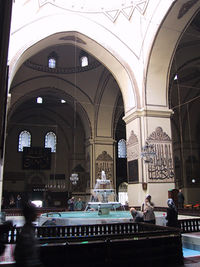
Ulu Cami is the largest mosque in Bursa and a landmark of early Ottoman architecture, which carried many elements from the Seljuk architecture. Ordered by Sultan Bayezid I, the mosque was designed and built by architect Ali Neccar in 1396–1400. It is a large and rectangular building, with a total of twenty domes that are arranged in four rows of five, and are supported by twelve columns. Supposedly the twenty domes were built instead of the twenty separate mosques which Sultan Bayezid I had promised for winning the Battle of Nicopolis in 1396. The mosque has two minarets.
Inside the mosque there are 192 monumental wall inscriptions written by the famous calligraphers of that period. There is also a fountain (şadırvan) where worshipers can perform ritual ablutions before prayer; the dome over the şadırvan is capped by a skylight which creates a soft, serene light below; thus playing an important role in the illumination of the large building.
The horizontally spacious and dimly lit interior is designed to feel peaceful and contemplative. The subdivisions of space formed by multiple domes and pillars create a sense of privacy and even intimacy. This atmosphere contrasts with the later Ottoman mosques (see for example the works of Suleiman the Magnificent's chief architect Mimar Sinan.) The mosques that were built after the conquest of Constantinople (Istanbul) by the Ottoman Turks in 1453, and influenced by the design of the 6th century Byzantine basilica of Hagia Sophia, had increasingly elevated and large central domes, which create a vertical emphasis that is intended to be more overwhelming; in order to convey the divine power of Allah, the majesty of the Ottoman Sultan, and the governmental authority of the Ottoman State.
Sports
The city has one professional football team competing in the top-flight of Turkish football - Bursaspor, currently playing in the Super Lig. On 16 May 2010, Bursaspor won the Turkish Super League title on the last game of the season, edging out perennial favourite Fenerbahce by a single point. This marked the first instance since the 1983-1984 Turkish Super League season that a team outside of Istanbul was crowned champions of Turkey's top division of association football.[8]
Image gallery
 Statue of Atatürk and the Governorship of Bursa |
 Bursa Clock Tower in the historic Tophane district |
 The contiguous tombs of Karagöz and Hacivat in Bursa |
 View from the Tophane district in the historic city center |
Bursa Castle |
 Governorship of Bursa |
 Sarcophagus in the Bursa Archaeological Museum |
 Bursaray |
 Cumhuriyet Caddesi |
 Irgandi Bridge |
|
Atatürk Museum |
 Bursa Castle |
 Uzun Çarşı (Long Bazaar) |
 Minaret of the Bursa Great Mosque |
 Statue of Atatürk in the centrum |
 Mudanya district in Bursa Province |
 Mudanya |
Uludağ is a popular ski destination in Turkey |
 Uludağ as seen in the summer |
 Uludağ |
International relations
Twin towns—Sister cities
Bursa has twenty sister cities. Vinnitsa is the latest to become a sister city of Bursa.[9]
Notable residents
- Dio Chrysostom- Greek orator, writer, philosopher and historian of the Roman Empire
- Asklepiades - physician
- Adnan Şenses- singer
- Ata Demirer- comedian
- Behice Boran- the leader of the socialist Workers Party of Turkey
- Bayezid I - Fourth Ottoman Empire ruler.
- Celal Bayar- former Turkish president
- Duygu Ulaş- fashion model
- Emre Aşık- international footballer
- Erdal Özyağcılar- actor
- Erkan Can- actor
- Hamit Şare- Olympic skier
- Hande Ataizi- actress
- Halil Ergün- actor
- İhsan Sabri Çağlayangil- politician
- İlhan İrem- singer
- Manolis Andronikos (1919–1992) Greek archaeologist
- Mehmed I - Fifth Ottoman Empire ruler.
- Mercan Dede, Turkish musician
- Muazzez İlmiye Çığ- archaeologist
- Murad I- Third Ottoman Empire ruler.
- Müzeyyen Senar – singer, state artist of Turkey
- Nur Sürer- actress
- Olgun Şimşek- actor
- Okan Yılmaz- international footballer
- Özhan Canaydın- former basketball player, businessman and the former chairman of Galatasaray
- Pınar Kür- author
- Qādī Zāda al-Rūmī- astronomer and mathematician
- Sabiha Gökçen- the first Turkish female aviator and the first female combat pilot in the world
- Şefik Bursalı- artist
- Serdar Kurtuluş- International footballer
- Tarkan Gozubuyuk- Pentagram/Mezarkabul Bass Guitar Player / Producer
- Sercan Yıldırım - International footballer
- Sporus of Nicaea- Greek mathematician and astronomer
- Suzan Avcı- actress
- Tarık Tarcan- actor
- Vedat Okyar- footballer
- Vildan Atasever- actress
- Yıldırım Gürses- actor, composer
- Yıldırım Mayruk- fashion designer
- Zeki Müren- well known singer, "sun of art"
See also
- 1855 Bursa earthquake
- Bursa Airport
- Bursaray
- Complex of Mehmed I
References
Notes
- ↑ Türkiye istatistik kurumu Address-based population survey 2007. Retrieved on 2008-03-21.
- ↑ [1] Address-based population survey 2009. Retrieved on 2010-01-25.
- ↑ "Bayezid I Complex". ArchNet. http://www.archnet.org/library/sites/one-site.jsp?site_id=2872. Retrieved 2009-06-28.
- ↑ "Great Mosque of Bursa". ArchNet. http://www.archnet.org/library/sites/one-site.jsp?site_id=2881. Retrieved 2009-06-28.
- ↑ "Turkey’s automotive industry going nonstop". Today's Zaman. 2007-05-05. http://www.todayszaman.com/tz-web/detaylar.do?load=detay&link=110361. Retrieved 2009-06-28.
- ↑ "TAYSAD met its members from Bursa". TAYSAD. 2008-02-08. http://www.taysad.org.tr/www/tr/default.asp?x=haber_detay&hid=31. Retrieved 2009-06-28.
- ↑ "Bursa'nın İlk 250 Sanayi Kuruluşu". BTSO. 2008. http://www.ilk250.org.tr/document/2008/2008.xls.
- ↑ http://www.hurriyetdailynews.com/n.php?n=bursaspor-leads-the-way-in-football-revolution-2010-05-17
- ↑ Bursa Metropolitan Municipality Web Site; Sister Cities.
- ↑ Town Twinnings and international relations (from the official city website. Accessed 2008-08-11.)
- ↑ "Twin towns". www.ouka.fi. http://www.ouka.fi/kansainvalisyys/english/ystavyyskaupungit.html. Retrieved 2009-11-07.
- ↑ "Partnership towns of the City of Košice" (in Slovak). © 2007-2009 City of Košice Magistrát mesta Košice, Tr. SNP 48/A, 040 11 Košice. http://www.kosice.sk/clanok.asp?file=gov_s_c-00.html. Retrieved 2009-07-12.
- ↑ "Turkey's Bursa, Kosovo's Pristina become sister cities" worldbulletin.net 02 September 2010 Link accessed 02 September 2010
External links
- Uludağ University
- Bursa Metropolitan Municipality
- (Turkish) Bursa Kultur AS. (Bursa Metropolitan Municipality)
- (Turkish) Enjoy Bursa (Bursa Metropolitan Municipality)
- Bursa Weather Forecast Information
- (Turkish) Bursa - Orhangazi Business Guide
- Pictures of Bursa
- (Turkish) Golyaka Village, Bursa
- http://www.bursadakultur.org - Arts and culture in Bursa - Bursa'da kultur & Sanat
- (Turkish) Latest Local News from Bursa
- (Turkish) Bursa City Guide
- (Turkish) Bursa News
- (Turkish) Bursa Guide
- (Turkish) Bursa Local News
- (Turkish) Bursa Local News & Guide
- (Turkish) Bursa real estate
- Bursa Haber
|
||||||||||||||||||||||||||||||||||
|
|||||

